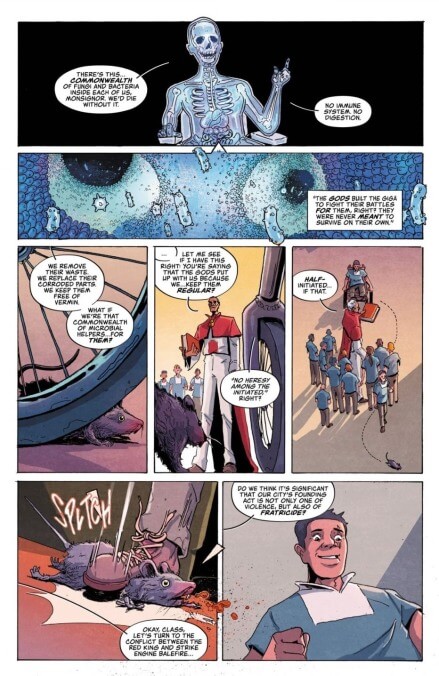The mech-centric dystopia of GIGA #1 is the beginning of something exciting

There’s been a lot of buzz around GIGA, the new mech-centric dystopian series from Vault Comics. Based on the first issue, the hype seems justified: It reads like a buzz-worthy comic, full of scope and scale, with a bright creative team that is clearly not holding back.
The premise of the series is fairly straightforward: Mechs came to earth, had titanic battles, and then went dormant, which has allowed people to live inside of them. But the execution of the premise gives the series its unique voice. This world, in its full complexity, is clearly realized on the page. It looks lived-in and old, a setting with history and culture and its own logic. The theory (floated early in the story by protagonist Evan Calhoun) of humanity serving a similar role to giant mechs as bacteria do to humans excites the imagination while emphasizing the size and power of the Giga in comparison to the people who rely on them.
The story begins with Evan Calhoun as a novice within the “Order Of The Red Relay,” which is supposedly meant to interpret what the dormant Giga might want and to enforce their will. Early on in the issue (and through no fault of his own), Evan is banished to live on the fringes of what used to be his life. Because of this setup, we briefly get to see the inner circle of power before being relegated to the world of those who have none. Evan’s a character with a past—and one with secrets, which makes him interesting to follow. He’s stubborn, smart, and holds to his own beliefs, even when it seems fairly self-destructive to do so. He’s flawed, but probably less so than the world around him.
While the characters introduced in this issue feel fully fleshed out, at times the dialogue can feel overwritten, as if writer Alex Paknadel doesn’t trust that the reader will follow along without immediate explanations behind the universe’s vocabulary and the interpersonal dynamics of the story. The issue is heavy on exposition—especially in its first scene, almost to the point of clunkiness. But that’s often the case in comics that are setting up to take big swings, and this heaviness will hopefully taper off after the first few issues.
John Lê’s art is measured and intricate, steeping the movement of the story with symbolism and visual metaphor. When the choreography of the pages shifts the visuals in scale, his work dazzles. Though a facial expression or two may fall a little flat, his art mostly soars with the help of colorist ROSH, who’s reserved when he has to be, and leans into wonder when required. ROSH works in the dystopian staples of purples, oranges, and teals, but instead of the colors feeling like an echo of what came before, they feel like a conversation—between how these ideas have been used in the past and how they will be used in this story. Additionally, Aditya Bidikar’s letters are a notable standout: They’re lean and creative, always meeting each moment appropriately. His style for the comic is streamlined (the balloons have black-and-white line tails instead of tapering ones) but also playful, adding yet another interesting element to the visual identity of this comic.
Despite some small dings, GIGA #1 reads like the beginning of something exciting. It feels like a well-thought-out sci-fi series that is bound to reward its readers over time.
